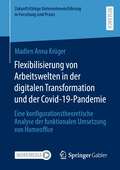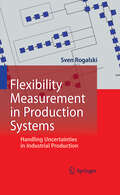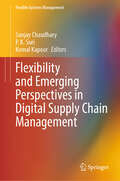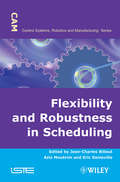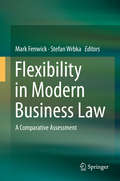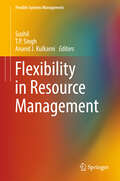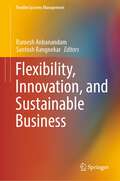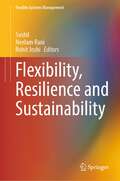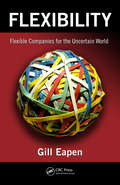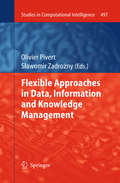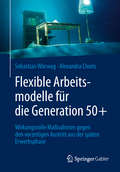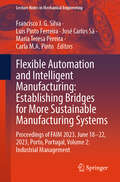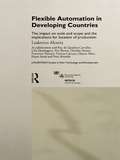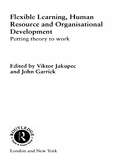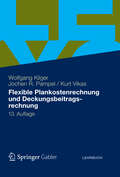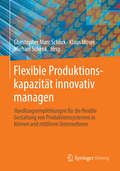- Table View
- List View
Flexibilisierung von Arbeitswelten in der digitalen Transformation und der Covid-19-Pandemie: Eine konfigurationstheoretische Analyse der funktionalen Umsetzung von Homeoffice (Zukunftsfähige Unternehmensführung in Forschung und Praxis)
by Madlen Anna KrügerDie Flexibilisierung von Arbeitswelten stellt eine zentrale Maßnahme für Unternehmen dar, um auf neue Anforderungen der Umwelt zu reagieren. Die Umsetzung flexibler Arbeitsmodelle muss daher wissenschaftlich erforscht und auf dieser Basis in der Praxis konkret gestaltet werden. Das vorliegende Buch untersucht empirisch die erfolgreiche Umsetzung von Homeoffice vor einem konfigurationstheoretischen Hintergrund. Es wird aufgezeigt, welche Faktoren die Umsetzung von Homeoffice in Organisationen beeinflussen, welche Konfigurationen von Faktoren in der Praxis besonders erfolgreich sind, und durch welche HR-Maßnahmen das Arbeitsmodell konkret gestaltet werden kann. Die Ergebnisse knüpfen an aktuelle Forschungen zu organisationalen Konfigurationen und zu neuen Arbeitswelten an und tragen außerdem dazu bei, künftig mehr positive Potentiale von Homeoffice nutzbar zu machen. Dazu gehören momentan besonders die Aufrechterhaltung des Arbeitsbetriebes während der Pandemie, eine leichtere Einbindung aller Arbeitskräfte in das Erwerbsleben und eine fortschreitende Gleichstellung der Geschlechter sowie ein sinkendes Verkehrsaufkommen in Zeiten des Klimawandels.
Flexibility Measurement in Production Systems
by Sven RogalskiThe requirements for production systems are constantly changing as a result of changing competitive conditions. This poses a challenge for manufacturers in the various branches of industry and creates an ever-increasing need for flexibility. With this as a background, this book explores the current developments and trends as well as their impact on today's production systems. It also compares known strategies, concepts and methods used to achieve production flexibility. Similarly, the practical knowledge and current research will be drawn upon and subjected to a sound scientific analysis, through which the technical and organizational flexibility ranges can be measured in their application in a production system. The convenience and usefulness of this concept for manufacturers is substantiated by its implementation in a software tool called ecoFLEX and its practical application, based on extensive examples. This illustrates how flexibility flaws can be quickly identified, classified and properly disposed of using ecoFLEX. This tool helps to close the gap between ERP / PPS systems and digital factory planning tools.
Flexibility and Emerging Perspectives in Digital Supply Chain Management (Flexible Systems Management)
by P. K. Suri Sanjay Chaudhary Komal KapoorThis book offers a comprehensive and forward-thinking exploration of how digital technologies are reshaping the landscape of supply chain management. With a focus on embracing innovative technologies and flexibility, this book illustrates how businesses can achieve greater efficiency, sustainability, and competitive advantage in today's dynamic global marketplace. The book shall help students and practitioners to evaluate the supply chain and make changes if required for digital transformation.
Flexibility and Real Estate Valuation under Uncertainty: A Practical Guide for Developers
by Richard De Neufville David GeltnerProvides a revolutionary conceptual framework and practical tools to quantify uncertainty and recognize the value of flexibility in real estate developmentThis book takes a practical "engineering" approach to the valuation of options and flexibility in real estate. It presents simple simulation models built in universal spreadsheet software such as Microsoft Excel®. These realistically reflect the varying and erratic sources of uncertainty and price dynamics that uniquely characterize real estate. The text covers new analytic procedures that are valuable for existing properties and enable a new, more profitable perspective on the planning, design, operation, and evaluation of large-scale, multi-phase development projects. The book thereby aims to significantly improve valuation and investment decision making.Flexibility and Real Estate Valuation under Uncertainty: A Practical Guide for Developers is presented at 3 levels. First, it introduces and explains the concepts underlying the approach at a basic level accessible to non-technical and non-specialized readers. Its introductory and concluding chapters present the important “big picture” implications of the analysis for economics and valuation and for project design and investment decision making.At a second level, the book presents a framework, a roadmap for the prospective analyst. It describes the practical tools in detail, taking care to go through the elements of the approach step-by-step for clarity and easy reference.The third level includes more technical details and specific models. An Appendix discusses the technical details of real estate price dynamics. Associated web pages provide electronic spreadsheet templates for the models used as examples in the book. Some features of the book include:• Concepts and tools that are simple and accessible to a broad audience of practitioners;• An approach relevant for all development projects;• Complementarity with the author's Commercial Real Estate Analysis & Investments—the most-cited real estate investments textbook on the market.Flexibility and Real Estate Valuation under Uncertainty: A Practical Guide for Developers is for everyone studying or concerned with the implementation of large-scale or multi-phase real estate development projects, as well as property investment and valuation more generally.
Flexibility and Robustness in Scheduling (Wiley-iste Ser.)
by Jean-Charles Billaut Aziz Moukrim Eric SanlavilleScheduling is a broad research area and scheduling problems arise from several application domains (production systems, logistic, computer science, etc.). Solving scheduling problems requires tools of combinatorial optimization, exact or approximated algorithms. Flexibility is at the frontier between predictive deterministic approaches and reactive or ?on-line? approaches. The purpose of flexibility is to provide one or more solutions adapted to the context of the application in order to provide the ideal solution. This book focuses on the integration of flexibility and robustness considerations in the study of scheduling problems. After considering both flexibility and robustness, it then covers various scheduling problems, treated with an emphasis on flexibility or robustness, or both.
Flexibility in Modern Business Law
by Stefan Wrbka Mark FenwickThis book brings together a number of contributions examining how changes associated with economic globalization have contributed to the creation of new pressures on, and expectations of, those fields of law connected to the regulation of cross-border commercial transactions. These new demands of law - in particular, that it be more agile or "flexible" in regulating the economy - have prompted lawmakers and regulators in multiple jurisdictions to adopt a range of new regulatory techniques and legal forms to respond to this challenge. In many cases, these adaptations in law have entailed compromising traditional legal principles, such as legal certainty, in favor of empowering regulators with greater discretion than has traditionally been permitted in modern law. This change raises important questions about the meaning of fairness (certainty or flexibility), as well as the relationship between the public and private good.
Flexibility in Resource Management (Flexible Systems Management)
by Sushil, T. P. Singh and Anand J. KulkarniThis book provides a conceptual ‘Flexibility in Resource Management’ framework supported by research/case applications in various related areas. It links and integrates the flexibility aspect with resource management to offer a fresh perspective, since flexibility in different levels of resource management is emerging as a key concern -- a business enterprise needs to have reactive flexibility (as adaptiveness and responsiveness) to cope with the changing and uncertain business environment. It may also endeavor to intentionally create flexibility by way of leadership change, re-engineering, innovation in products and processes, use of information and communication technology, and so on. The selected papers discussing a variety of issues concerning flexibility in resource management, are organized into following four parts: flexibility and innovation; flexibility in organizational management; operations and technology management; and financial and risk management. In addition to addressing the organizational needs of corporate bodies spread across the globe, the book serves as a useful reference resource for a variety of audiences including management students, researchers, business managers, consultants and professional institutes.
Flexibility, Innovation, and Sustainable Business (Flexible Systems Management)
by Ramesh Anbanandam Santosh RangnekarThis book contains practical experiences, knowledge, and insights in the evolution, formulation, and implementation of strategies and models for flexibility, innovation, and sustainable business. The book discussed the increasing significance of a flexible approach by businesses as much as possible in every area of their work—from employment policies to supply chain management (SCM). It further links this flexible approach to a sustainability strategy, which is necessary to be competitive today and in the future. This business approach is necessary to create long-term value by considering how a given organization operates in the ecological, social, and economic environment. This is linked to the next theme of the book—innovation—which is fundamental for a business to improve its processes, develop new and improved products and services for the market, increase its efficiency, and, most importantly, get better profitability. The book also delves into another buzz word in business—analytics. Companies have widely embraced the use of analytics to streamline operations and improve processes. The book explores all these critical emerging areas through the chapters in its five sections and is invaluable for management students and researchers, practicing business managers, consultants, professional institutions, and government and corporate organizations.
Flexibility, Mobility and the Labour Market (Routledge Library Editions: Labour Economics #6)
by George S. CallaghanFirst published in 1997. Politicians of all shades argue that the labour market should be more flexible and workers more mobile. But what does this mean in reality? How flexible and mobile are workers likely to be? Is there an ideological base to the language of flexibility? These are some of the issues covered in this book. Data from a large factory and office is used to argue that the macro labour market consists of non-competitive work groups where strongly held views and values represent a substantial barrier to simplistic definitions of flexibility and mobility. The analysis takes place in three chapters, dealing with recruitment for work, skills used in work and perceptions of different types of work and workers. The findings suggest that non-economic forces (such as institutional, social, historical and political phenomena) strongly influence the creation of separate work cultures. Furthermore, it is argued that the reason for differences between work groups being articulated in a defensive fashion reflects the climate of fear in the labour market, where flexibility is associated with a loss of the (often limited) power, control and influence workers have over their position in the labour market.
Flexibility, Resilience and Sustainability (Flexible Systems Management)
by Sushil Neelam Rani Rohit JoshiThis book discusses initiatives intended to promote strategic flexibility, resilience, sustainability, and information system flexibility and analytics, through AI, HR analytics, employee attrition using perspectives from machine learning, agile competencies, agile organization, digital recruitment, e-governance, cyber security controls, and cyber security risk management. It explores areas such as banking system, medical tourism, pharmaceutical industry, defense sector, online shopping, to name some. It brings different perspectives on how to improve the resilience of human resources in organizations through employee engagement, exploration, experimentation, and so on, to create sustainable organizations. There is also some focus on innovation and environmental sustainability concerns, co-worker support, exploring the linkages, and in one case, culture essentials for Industry 5.0. Divided into three parts, covering a range of topics, contexts, and methods used to understand the relevant issues in flexibility, resilience, and sustainability, thes book is a useful addition to the literature on the topic as well as a practical resource for practitioners. It will be a useful resource for a variety of audiences such as management students and researchers, practicing business managers, consultants, and professional institutions.
Flexibility: Flexible Companies for the Uncertain World
by Gill EapenWe are in an era of high volatility and uncertain outcomes, driven by accelerating technologies, shortened product cycles, fast-changing information, an increasingly mobile workforce, more demanding customers, complex financial markets, ad-hoc public policies, and many other factors that add layers of uncertainty to all future possibilities. In an information- and knowledge-driven environment with high levels of uncertainty, most traditional ideas of structure, system, and strategy are ineffective. This book shows how to create, maintain, and accelerate an organization in a highly uncertain environment using flexibility. It analyzes the organization holistically and details its primary components independently. The author presents an economic framework of decision options to diagnose existing flexibility problems and provides guidance on how to improve flexibility and reduce risk. The text also describes how to design and maintain a high performance organization for the long run in an environment of high uncertainty.
Flexible Approaches in Data, Information and Knowledge Management
by Olivier Pivert Sławomir ZadrożnyThis volume showcases contributions from internationally-known researchers in the field of information management. Most of the approaches presented here make use of fuzzy logic, introduced by L. A. Zadeh almost 50 years ago, which constitute a powerful tool to model and handle gradual concepts. What all of these contributions have in common is placing the user at the center of the information system, be it for helping him/her to query a data set, to handle imperfect information, or to discover useful knowledge from a massive collection of data. Researchers working in data and knowledge management will greatly benefit from this collection of up-to-date studies. This may be also an invaluable source of information for postgraduate students interested in advanced information management techniques.
Flexible Arbeitsmodelle für die Generation 50+: Wirkungsvolle Maßnahmen gegen den vorzeitigen Austritt aus der späten Erwerbsphase
by Sebastian Wörwag Alexandra ClootsDieses Fachbuch präsentiert basierend auf den Ergebnissen einer breit abgestützten Studie flexible Arbeitsmodelle, die bei der Zielgruppe der Erwerbstätigen im Alter von über 50 Jahren zu einer Weiterbeschäftigung bis zum Rentenalter und darüber hinaus führen können. HR-Verantwortliche, Führungskräfte und interessierte Mitarbeitende erlernen Strategien, mit denen sie dem Fachkräftemangel wirksam entgegenwirken sowie zu Gesunderhaltung, Motivationssteigerung und verbesserter Arbeitsfähigkeit der Beschäftigten beitragen können. Ein systemisches Modell stellt die Einflussfaktoren nachhaltig guter Arbeit dar, ein Trendkapitel zeigt die künftigen Herausforderungen, und konkrete Flexibilisierungsmodelle sowie Fallstudien erleichtern die Umsetzung der Erkenntnisse in die Praxis.
Flexible Automation and Intelligent Manufacturing: Proceedings of FAIM 2023, June 18–22, 2023, Porto, Portugal, Volume 2: Industrial Management (Lecture Notes in Mechanical Engineering)
by Carla M. A. Pinto José Carlos Sá Francisco J. G. Silva Luís Pinto Ferreira Maria Teresa PereiraThis book reports on cutting-edge research and developments in manufacturing, giving a special emphasis to solutions fostering automation, sustainability and health, safety and well-being at work. Topics cover manufacturing process analysis and optimization, supply chain management, quality control, as well as human factors and logistics. They highlight the role and advantages of intelligent systems and technologies, discussing current best-practices and challenges to cope with in the near future. Based on proceedings of the 32nd edition of the International Conference on Flexible Automation and Intelligent Manufacturing, FAIM 2023, held on June 18–22, 2023, in Porto, Portugal, this second volume of a 2-volume set provides academics and professionals with extensive information on innovative strategies for industrial management in the era of industry 5.0.
Flexible Automation in Developing Countries: The impact on scale and scope and the implications for location of production (UNU/INTECH Studies in New Technology and Development)
by Ludovico AlcortaThis book examines the extent of, and motives for, the diffusion of flexible automation (FA) at global level and then turns to the local and firm level, bringing together in-depth studies of sixty-two firms in Brazil, India, Mexico, Thailand, Turkey and Venezuela. Research focuses on the impact of computer-numerically-controlled machine tools on scale and scope by exploring changes in lot sizes and product variety (product scale and scope), total plant output (plant scale) and total firm output (firm scale). Barriers to setting up FA-based operations are discussed, as are factors which may affect a decision to locate in a developing country. The contributed studies reveal a relatively slow diffusion of FA in developing countries and it is demonstrated that while FA possibly increases scope, it also requires that plant output be increased in order to maintain efficiency. Alcorta concludes that the location in developing countries will probably only be viable for large domestic firms, multinationals seeking to relocate simple but labour intensive assembly processes and firms in countries with significant domestic markets. This work is unique in addressing the scale and scope issues in developing countries and in the wealth of information regarding machine tools which it provides. The data provided in the appendix includes official United Nations data, previously unpublished. This will be of use for all research into trends in the use of machine tools.
Flexible Compensation and Benefits: Why Variety Will Rule and How to Leverage It
by Ken Dychtwald Tamara J. Erickson Robert MorisonCompensation and benefits should work for employees and for the business-as levers with which the company can meet employee needs, enable their productivity, and improve their performance. This chapter addresses the challenge of managing compensation and benefits and getting all the facets of the deal "right."
Flexible Firm: The Design of Culture at Bang & Olufsen
by Jakob Krause-JensenBang & Olufsen, the famous Danish producer of high-end home electronics, is well known as an early exponent of value-based management: the idea that there should be consistency in what the organisation does, a certain continuity between what the company develops and sells, and the beliefs and practices of the employees. This study investigates how company values are communicated and the collective identity is articulated through the use of such concepts as 'culture', 'fundamental values', and 'corporate religion', as well as how employees negotiate these ideas in their daily working lives. As this book reveals, the identification of values, meant to create cohesion and solidarity among employees, came to symbolise and engender a split between the staff and the other parts of the company. By examining the rise and fall of the value-based management approach, this volume offers the indispensible insight of anthropological enquiry to expose how social realities challenge conventional management strategies and therefore must be considered in the development of new management techniques.
Flexible Human Resource Management and Vocational Behaviour: The Employability Market Orientation Model (Routledge Studies in Management, Organizations and Society)
by Anna PawłowskaThe Employability Market Orientation (EMO) model, which is more extensive than traditional approaches in the field of personal marketing, along with a questionnaire for its measurement, makes the employee "anti-fragile" behaving as a micro-entrepreneur (workpreneur). It achieves high levels of employability and marketability and low job insecurity. This attitude has consequences for employers such as low employee loyalty and commitment. Thus, HR specialists will be able to develop adequate solutions and methods reducing the effects of retention. The EMO questionnaire contained in the book will allow them to diagnose such attitudes. This book guides readers through the world of the rules of the contemporary labor market with the end of life-long employment, encouraging to have proactive attitude by both the employee and the employer. Its originality lies in the fact that it focuses on employees who can be adopted, not being victims of flexible human resource management. It is written in an objective manner, supported by reliable research with advanced statistical analysis, and will be of value to researchers of management, the labor market, career counselling, sociologists and work psychologists. Proposed indicators of often imprecise concepts such as mobility and professional flexibility are explored. These concepts will help scholars to conduct research on new phenomena and develop theories of modern organization with disappearing borders and transactional relations.
Flexible Human Resource Management and Vocational Behaviour: The Employability Market Orientation Model (Routledge Studies in Management, Organizations and Society)
by Anna PawłowskaThe Employability Market Orientation (EMO) model, which is more extensive than traditional approaches in the field of personal marketing, along with a questionnaire for its measurement, makes the employee "anti-fragile" behaving as a micro-entrepreneur (workpreneur). It achieves high levels of employability and marketability and low job insecurity. This attitude has consequences for employers such as low employee loyalty and commitment. Thus, HR specialists will be able to develop adequate solutions and methods reducing the effects of retention. The EMO questionnaire contained in the book will allow them to diagnose such attitudes.This book guides readers through the world of the rules of the contemporary labor market with the end of life-long employment, encouraging to have a proactive attitude by both the employee and the employer. Its originality lies in the fact that it focuses on employees who can be adopted, not being victims of flexible human resource management. It is written in an objective manner, supported by reliable research with advanced statistical analysis, and will be of value to researchers of management, the labor market, career counselling, sociologists and work psychologists. Proposed indicators of often imprecise concepts such as mobility and professional flexibility are explored. These concepts will help scholars to conduct research on new phenomena and develop theories of modern organization with disappearing borders and transactional relations.
Flexible Leadership: Navigate Uncertainty and Lead with Confidence
by Kevin EikenberryBecome a more flexible leader in today&’s unpredictable world with a revolutionary approach to applying leadership skills—while remaining steadfast in proven principles and your values.Despite the billions of dollars invested every year into leadership development, leaders aren&’t collectively becoming more successful. Existing tools like assessments, models, and styles have proven largely inadequate in equipping leaders for today&’s age of work. For leaders to succeed in a landscape more unpredictable than ever, they need a new perspective and a brand-new set of skills that center around what is missing in the models and existing tools: flexibility. Kevin Eikenberry, Chief Potential Officer of the Kevin Eikenberry Group, a leadership consulting company centered on a philosophy of lifelong learning, explains the need for and how to effectively harness this essential flexibility in this guide for leaders at all levels. A roadmap outlining a new toolkit for leaders frustrated with their current effectiveness and confidence, Flexible Leadership teaches readers to: Distinguish between what has and hasn&’t changed in the world of work—enabling them to lead with greater success and leverage flexibility more effectively Efficiently use, but not rely on, existing and familiar leadership models Apply a framework to be more situationally flexible and effective every day without compromising their values The flexible leader has a clear mindset and increased confidence knowing that they can respond to their everyday situations with greater success, instead of being overly reliant on restrictive and complicated tools that can get in the way. Flexible Leadership is every leader&’s guide to greater success in a world of increasing complexity and chaos.
Flexible Learning Opportunities: Why Continuous Education Matters and How to Make It Pay Off
by Ken Dychtwald Tamara J. Erickson Robert MorisonLearning is integral to an organization's capability and productivity, recruiting and retention, and leadership and capacity for change, but with the coming shortage of skills and labor, learning also becomes a business performance imperative. In this chapter, the authors provide the tools necessary for building a learning organization, and address diverse learning opportunities for the three worker cohorts.
Flexible Learning, Human Resource and Organisational Development: Putting Theory to Work
by Viktor Jakupec John GarrickRecent challenges facing higher and tertiary education such as the impact of globalisation and the emergence of new technologies, have called for a radical reconceptualisation of the teaching-learning nexus.This book addresses contemporary contexts of flexible learning and its practices, and provides insights about directions in which education and
Flexible Manufacturing Systems: Planning Issues and Solutions (Studies on Industrial Productivity: Selected Works #5)
by Zubair M. MohamedOriginally published in 1994 this book undertakes a comprehensive study dealing with the effects of machine flexibility, tool magazine capacity, varying production demands and different oeprating policies on the production planning problems. Performance measures such as FMS flexibility, makespan and inventory are used in evaluating the effects. Three measures of FMS flexibility - actual routing flexibility, potential routing flexibility and capacity flexibility are defined and operationalized.
Flexible Plankostenrechnung und Deckungsbeitragsrechnung
by Kurt Vikas Jochen R. Pampel Wolfgang KilgerMit der 13. Auflage der "Flexiblen Plankostenrechnung und Deckungsbeitragsrechnung" wird der zukunftsweisende Weg Wolfgang Kilgers für praxisgerechtes Kosten- und Erlösmanagement konsequent weiter geführt. Vollständig aktualisiert bietet dieses Standardwerk den State-of-the-Art einer modernen Plankosten- und Deckungsbeitragsrechnung. Ohne die bewährte Grundstruktur zu verändern, gehen Kurt Vikas und Jochen Pampel auf alle wichtigen aktuellen Entwicklungen ein. Schwerpunkte der Überarbeitung: Die Aufnahme neuester relevanter Entwicklungen im Rechnungswesen und Controlling aus Unternehmenspraxis und Theorie in der Einführung; die Herauslösung des bewährten Modellbetriebes aus dem laufenden Text und komprimierte Darstellung und Erläuterung des Zahlenflusses in einem eigenen Kapitel; die Übernahme des von Kurt Vikas entwickelten, geschlossenen und abstimmfähigen Zahlenmodells für eine Grenzplankosten- und Deckungsbeitragsrechnung "QUATTRO" zur Abrundung der Lehrbuchfunktion sowie die geänderten Anforderungen durch neue Rechnungslegungsvorschriften.
Flexible Produktionskapazität innovativ managen: Handlungsempfehlungen für die flexible Gestaltung von Produktionssystemen in kleinen und mittleren Unternehmen
by Christopher Marc Schlick, Klaus Moser and Michael SchenkDer flexible Einsatz von Mitarbeitern/-innen in produzierenden Unternehmen adressiert ein Thema von hoher wirtschaftlicher Bedeutung und Aktualität. Gestaltungsmöglichkeiten werden im Hinblick auf Produktionssysteme wie auch in Bezug auf den Einsatz der Personalressourcen behandelt. Produktionsplaner und Personalleitung erhalten konkrete Handlungsempfehlungen.Dieser praxisorientierte Handlungsleitfaden spricht insbesondere kleine und mittelständische Unternehmen an. "FlexPro - Flexible Produktionskapazität innovativ managen" war ein Forschungsprojekt in Unternehmen, dessen Ergebnisse als Grundlage dieses Leitfadens anschaulich erläutert werden.
